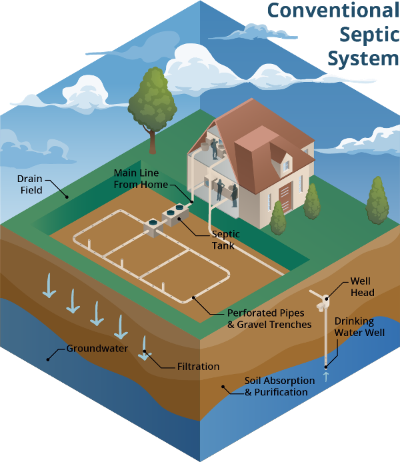The basic components of a septic system include the tank and a drain field (sometimes called a leach field). In Florida, nearly one in every three households depends on a septic system. UF/IFAS researchers estimate more than 2.5 million systems are in use across the state.
The tank is a water-tight container that’s buried in the ground. Solids and other materials are separated here. Solids settle on the bottom of the tank as sludge, and oils and grease float to the top. This is often referred to as the scum layer. Liquid wastewater forms the middle layer. This flows through pipes into the drain field where it is eventually absorbed into the ground.
While bacteria constantly break down the organic matter in your septic tank, buildup of solids does occur. That’s why periodic system cleanings (“pumping”) are necessary. Otherwise, solid material from the tank can flow into drain field pipes and block them from draining. Eventually, wastewater could back up through the pipes into your home and surrounding property.
- Learn more: Factsheet - Septic System Maintenance
Lifespan of Your Septic System
With proper maintenance, septic tanks can last up to 30 years. Tanks should be pumped every three to five years to ensure proper working order and to avoid complications. This timing can vary based on several factors, including the size of the tank, number of people in your household, and how much wastewater your home produces.
Septic System Concerns

Section-view illustration of a modern septic system under a residential property | UF/IFAS Photo
Domestic wastewater, or sewage, carries contaminants such as pathogens (bacteria and other microorganisms), nutrients (nitrogen and phosphorus), and trace organic compounds like pharmaceuticals, household chemicals, and pesticides. These can be harmful to human health and the environment. Proper treatment of wastewater is crucial, and septic systems can be one means of effective on-site wastewater treatment. For residents connected to sewage lines, wastewater is treated at a centralized water treatment plant.
Conventional septic systems have been widely used since the 1940s. They are designed from a public health perspective, and as long as they are properly sited and maintained (placed in adequate soils with proper setbacks from the water table), they do an excellent job in most instances of removing pathogens and protecting human health.
Conventional septic systems were not designed, however, to completely remove nutrients or trace organic compounds. A conventional septic tank removes only about 30 percent of the nitrogen that flows into it. That means even a well-maintained system will become a source of excess nitrogen (particularly nitrate-nitrogen) to the surrounding soil in the drainfield and can leach to groundwater.
- Learn More: The fate of Nitrogen, Phosphorus, Bacteria and Protozoa, Viruses, Trace Organic Chemicals in septic systems
Along with an unpleasant smell, failing septic systems can contaminate groundwater, private and public supply wells, and regional water bodies with excess nutrients and harmful pathogens, including E. coli. Proper maintenance is critical to prevent systems from failing.
Signs of a Failing Septic System
Your septic system could be failing if you notice foul odors coming from drains inside your home or around the septic tank and drain field. You might also experience slow drainage from bathtubs, showers, and sinks. In addition, you may observe standing water or overly-saturated soil in the areas near your septic tank. If this is the case, contact a certified septic tank contractor to inspect your septic system.
Septic System Maintenance
Pumping of your septic system must always be performed by a professional. However, there are ways you can ensure the system is in proper working order throughout the year. That includes flushing down the toilet only toilet paper and human waste. Never flush items such as napkins, facial tissues, cotton swabs, “flushable” wipes, or cigarette butts. Also, it's best to avoid pouring oil and fat into the kitchen drain. When possible, it’s best to limit use of your garbage disposal. Doing so will keep excess organic matter from building up inside your septic tank. Composting is a useful alternative.
- See Also: Septic System Maintenance (PDF)
You should also find ways to conserve water. This reduces the amount of liquid pumped into your septic tank. Water conservation techniques include repairing leaks, installing low-flow showerheads and toilets, and running washing machines and dishwashers at full capacity. If you have a large amount of laundry to wash, a good practice is to do the laundry over the course of several days.
Special care must be taken when septic systems are flooded, as can occur in Florida after heavy rains and hurricanes. The most effective thing you can do is relieve pressure on the septic system by not using it, or using it less until floodwaters recede and the soil surrounding the drainfield has drained. Septic systems can’t treat wastewater effectively when soils in the drainfield are waterlogged.
- See Also: Flooding and Septic Systems (PDF)

